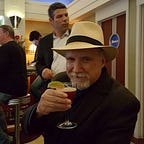The Living Room Bijou: “The French Dispatch” and the “Anderson Touch.”
Even after a second viewing, The French Dispatch is a hard movie to describe. Certainly, it’s a portmanteau film, a collection of vignettes. It’s also a comedy. About a magazine.
Well, okay, what else? One definite thing you can say about this most bright and cheerful comedy: It’s a Wes Anderson film.
The French Dispatch is also a tribute to The New Yorker as it was back in the mid-twentieth century, less heavy than it is now. Even as it published pioneer works of investigative journalism like John Hersey’s Hiroshima and Truman Capote’s In Cold Blood, the magazine was mostly renowned for exploring the eccentric and obscure corners of human experience with nimble elegance, sophistication, and wit. Whoever called it “the best magazine ever” was probably right.
It featured many of the best writers of that era, among them James Baldwin and Joseph Mitchell. (And, of course, there are the cartoons. Funny and not, there’s no New Yorker without them.) Eclectic and freewheeling, it’s unique voice and design bridged American and European sensibilities to make its own. Now with the world interconnected like never before, that bridge that is crumbling as new ones are being built and new ways of looking at the world are born.
There’s no going back to those days but we can celebrate them. In his nostalgic fashion, writer-director Wes Anderson reimagines that classic sensibility into delightful comic myth, even recreating the magazine’s look at that time with loving care. I haven’t always liked Anderson’s work, which can be too twee and forgettable despite his dazzling eye. (I remember the visuals, but what happened? And whom did it happen to? Don’t ask me.)
Even so, The Grand Budapest Hotel is one of my favorite movies of this century, so far. The French Dispatch doesn’t quite touch that high bar but it’s still a good Wes Anderson film: bright and exquisitely designed as a jewel box, rich with imagination and comic feeling, and often hilarious.
As The New Yorker looked like no other magazine, Anderson’s films, in their precise detail, bright colors, fierce symmetries and cockeyed playfulness, look like no one else’s. Call it the “Anderson Touch.”
